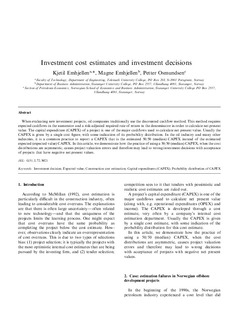| dc.contributor.author | Emhjellen, Kjetil | |
| dc.contributor.author | Emhjellen, Magne | |
| dc.contributor.author | Osmundsen, Petter | |
| dc.date.accessioned | 2007-03-09T10:33:01Z | |
| dc.date.accessioned | 2017-04-19T12:52:31Z | |
| dc.date.available | 2007-03-09T10:33:01Z | |
| dc.date.available | 2017-04-19T12:52:31Z | |
| dc.date.issued | 2002 | |
| dc.identifier.citation | Energy policy 30(2002), No. 2, p. 91-96 | |
| dc.identifier.issn | 0301-4215 | |
| dc.identifier.uri | http://hdl.handle.net/11250/2438543 | |
| dc.description.abstract | When evaluating new investment projects, oil companies traditionally use the discounted cashflow method. This method requires expected cashflows in the numerator and a risk-adjusted required rate of return in the denominator in order to calculate net present value. The capital expenditure (CAPEX) of a project is one of the major cashflows used to calculate net present value. Usually the CAPEX is given by a single cost figure, with some indication of its probability distribution. In the oil industry and many other industries, it is a common practice to report a CAPEX that is the estimated 50/50 (median) CAPEX instead of the estimated expected (expected value) CAPEX. In this article, we demonstrate how the practice of using a 50/50 (median) CAPEX, when the cost distributions are asymmetric, causes project valuation errors and therefore may lead to wrong investment decisions with acceptance of projects that have negative net present values. | |
| dc.format.extent | 195852 bytes | |
| dc.format.mimetype | application/pdf | |
| dc.language.iso | eng | |
| dc.publisher | Elsevier | |
| dc.subject | Investeringer | |
| dc.subject | Kostnader | |
| dc.subject | Kostnadsanalyser | |
| dc.subject | Petroleumsøkonomi | |
| dc.title | Investment cost estimates and investment decisions | |
| dc.type | Journal article | |
| dc.type | Peer reviewed | |
| dc.subject.nsi | 212 | |
| dc.identifier.doi | http://dx.doi.org/10.1016/S0301-4215(01)00065-9 | |
